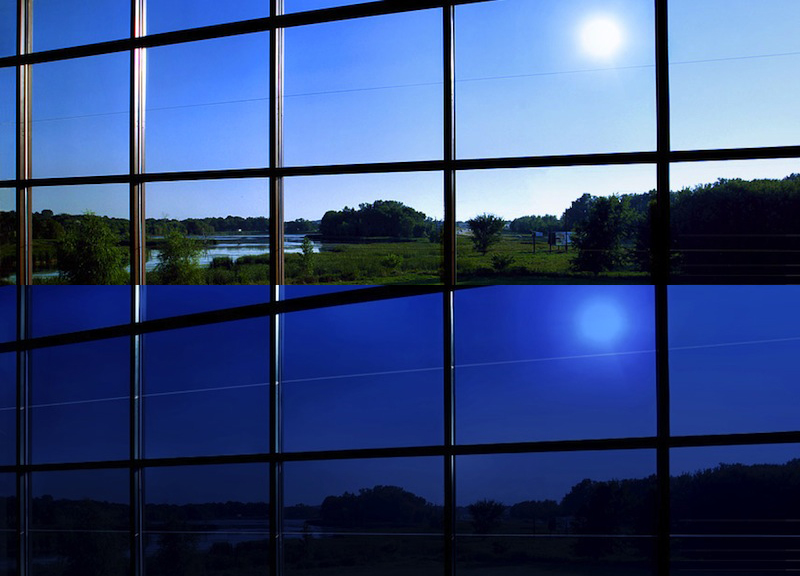New glazing technology is rapidly unfolding. Currently available technologies are seeing performance gains, and cutting-edge products and systems continue to gain a foothold in the mainstream.
Examples of such technologies include:
1. State-of-the-art IGUs. In addition to construction improvements like warm-edge spacers, IGUs are beginning to benefit from alternatives to gas fills. Aerogel insulation, made of synthetic solids that consist almost entirely of air, exhibits extremely low thermal conductivity. Some aerogels can be integrated with polycarbonate sheets to form a translucent cladding material, while others, such as silica aerogels in granular form, can fill the spaces between the glass lites of insulating units, says Ajla Aksamija, PhD, LEED AP BD+C, CDT, Building Technology Researcher with design firm Perkins+Will.
Aksamija also mentions vacuum-insulated glazing (VIG) units. “These units use a vacuum between lites of glass to raise the assembly’s thermal resistance,” she says. With no gas or fill, conduction and convection are virtually eliminated, which also allows the space between the lites (and total glazing thickness) to be greatly reduced, enhancing design flexibility. Patterson notes that vacuum glazing holds the most promise for producing vision glass with a U-factor good enough to justify continuing to build highly glazed facades. He cautions, however, that “a viable solution for widespread application seems to remain beyond the horizon.”
2. Electrochromic glass. Often called smart glass, electrochromic glazing alters its transmittance characteristics when an electrical current is applied, through the use of a specialized lamination that essentially integrates shading into the glazing unit. For instance, one type of smart glass appears frosted until the current is applied, at which point it becomes nearly transparent.
This technology has been in the works for some time, but cost has been a drag on broad market acceptance. There have been problems with the sealants, which are part of the system that carries the electrical current, says Joshua Zinder, AIA, Founding Principal of Joshua Zinder Architecture + Design, who has worked with the products on several occasions.
“A broken seal means a lost electrical connection in the lamination field, which means a loss of the electrochromic functionality in one or more adjacent panels,” he warns, but manufacturers are working to address this problem. “Electrochromic glazing appears to be on the verge of widespread adoption,” says Mic Patterson, Vice President of Strategic Development for Enclos. “The industry has recently invested in the manufacturing infrastructure necessary to produce materials with the right combination of aesthetic and performance attributes at a tolerable price point. These dynamic glazing materials still leave the problem of thermal performance.” Nevertheless, more use of smart glass is likely due to its flexible VLT, which can be integral to daylighting strategies that reduce illumination loads.
3. Building-integrated photovoltaics. In recent years, BIPV systems have shown signs of living up to their promise. With improvements in thin-film PV products to performance levels needed for use in vision glazing, they are getting closer to those of solid solar cells, used in spandrels and shading devices.
Façade orientation and inclination angle are both crucial to the successful integration of PV technology, and the improvement of thin films means that more of a project’s façade area can be integrated for solar harvesting without sacrificing transparency or translucence. Of course, BIPV is an energy-producing technology, not an energy-managing one: Passive solar, which works by managing the temperature of internal thermal mass, according to Cousins, is more closely associated with energy-managing techniques.
One cutting-edge technology is the integrated concentrating solar façade, or ICSF, currently in development by the Center for Architecture Science and Ecology (http://www.case.rpi.edu), a collaboration between Rensselaer Polytechnic Institute and Skidmore, Owings & Merrill. This is a dynamic façade system composed of moving gem-like solar collectors that can harvest daylight and fulfill a number of other energy requirements—heating, cooling, hot water, and electricity production.
4. Phase-change materials. PCMs are solid at room temperature but liquefy at higher temperatures, absorbing and storing heat in the process, says Aksamija. They are currently commercially available integrated into IGUs. Composed of either waxes or salts, PCMs can absorb high exterior temperatures by day and emit the heat to the interior at night.
5. Aluminosilicate glass, which is used to cover the displays of personal digital devices, is extremely thin and highly impact resistant. This glass type is essentially unheard of in building applications, because manufacturing large spans of the glass is prohibitively expensive. However, manufacturers are investing in improving the process because thin, impact-resistant glass could be an enormous boon to architectural glazing.
6. ETFE. Ethylene tetrafluoroethylene is a fluorine-based plastic originally conceived for its anti-corrosive properties, but which also demonstrates benefits for glazing applications, namely low weight, recyclability, and, in double- and triple-ply configurations with a gas fill, excellent thermal properties. But pumps are required to maintain constant air pressure relative to varying wind loads, and (worst-case scenario) when it burns the material releases hydrofluoric acid, which is highly toxic and corrosive.
Editor's note: This article was adapted from our recent AIA CES Discovery course, "Energy-efficiency Glazing Technology." Take the free course.
Related Stories
Giants 400 | Nov 13, 2023
Top 65 Airport Facility Engineering Firms for 2023
AECOM, Jacobs, Arup, Burns & McDonnell, and WSP head BD+C's ranking of the nation's largest airport terminal and airport facilities engineering and engineering architecture (EA) firms for 2023, as reported in the 2023 Giants 400 Report.
Giants 400 | Nov 13, 2023
Top 65 Airport Facility Architecture Firms for 2023
Gensler, Corgan, PGAL, and HOK top BD+C's ranking of the nation's largest airport terminal and airport facilities architecture and architecture engineering (AE) firms for 2023, as reported in the 2023 Giants 400 Report.
Building Materials | Oct 2, 2023
Purdue engineers develop intelligent architected materials
Purdue University civil engineers have developed innovative materials that can dissipate energy caused by various physical stresses without sustaining permanent damage.
Products and Materials | Sep 29, 2023
Top building products for September 2023
BD+C Editors break down 15 of the top building products this month, from smart light switches to glass wall systems.
Giants 400 | Aug 22, 2023
Top 115 Architecture Engineering Firms for 2023
Stantec, HDR, Page, HOK, and Arcadis North America top the rankings of the nation's largest architecture engineering (AE) firms for nonresidential building and multifamily housing work, as reported in Building Design+Construction's 2023 Giants 400 Report.
Giants 400 | Aug 22, 2023
2023 Giants 400 Report: Ranking the nation's largest architecture, engineering, and construction firms
A record 552 AEC firms submitted data for BD+C's 2023 Giants 400 Report. The final report includes 137 rankings across 25 building sectors and specialty categories.
Giants 400 | Aug 22, 2023
Top 175 Architecture Firms for 2023
Gensler, HKS, Perkins&Will, Corgan, and Perkins Eastman top the rankings of the nation's largest architecture firms for nonresidential building and multifamily housing work, as reported in Building Design+Construction's 2023 Giants 400 Report.
Standards | Jun 26, 2023
New Wi-Fi standard boosts indoor navigation, tracking accuracy in buildings
The recently released Wi-Fi standard, IEEE 802.11az enables more refined and accurate indoor location capabilities. As technology manufacturers incorporate the new standard in various devices, it will enable buildings, including malls, arenas, and stadiums, to provide new wayfinding and tracking features.
Architects | Jun 6, 2023
Taking storytelling to a new level in building design, with Gensler's Bob Weis and Andy Cohen
Bob Weis, formerly the head of Disney Imagineering, was recently hired by Gensler as its Global Immersive Experience Design Leader. He joins the firm's co-CEO Andy Cohen to discuss how Gensler will focus on storytelling to connect people to its projects.
Digital Twin | May 8, 2023
What AEC professionals should know about digital twins
A growing number of AEC firms and building owners are finding value in implementing digital twins to unify design, construction, and operational data.

















